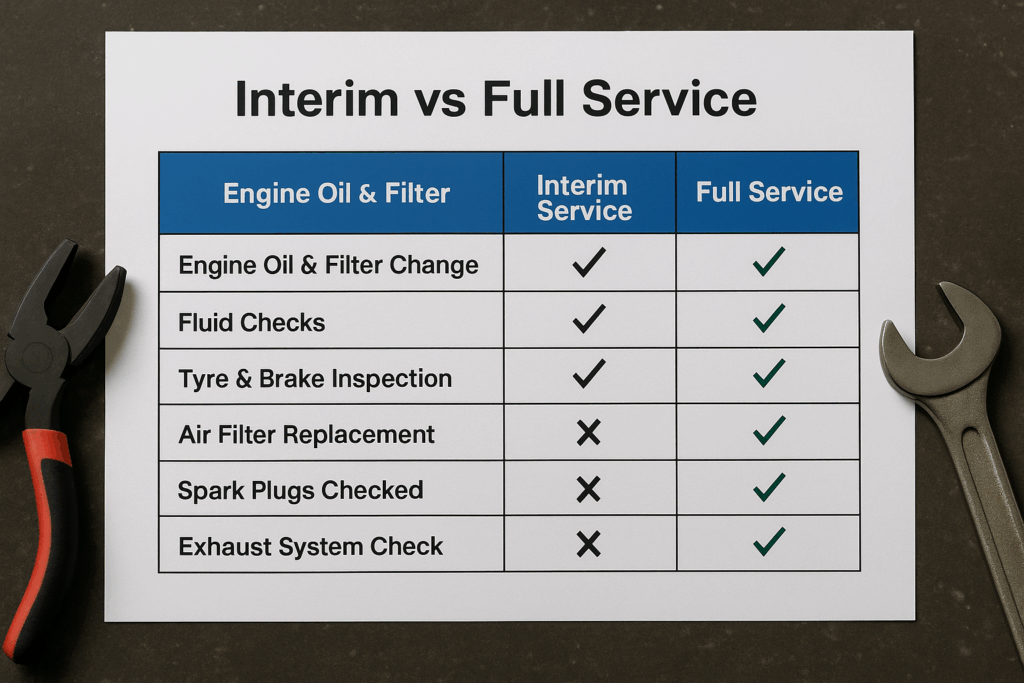Many car owners wrestle with the decision of whether to go for an interim service or a full service. At first glance, interim seems cheaper. However, when you dig into the details, the choice is not always straightforward. This article compares what each service involves, their costs in the UK, how often you need them, and helps you decide which option really saves you money over time.
What Is an Interim and What Is a Full Service
An interim service is a lighter check-up carried out more frequently. It focuses on essentials to keep your car running safely and reliably between more thorough check-ups. Typical items include engine oil and oil filter change, checking fluid levels (coolant, brake, screen wash), battery, tyres, lights, brakes, steering, suspension, and some basic safety checks.
A full service is more comprehensive. It includes everything in an interim service as well as additional checks and replacements such as the air filter, spark plugs, fuel filter, a more detailed inspection of the exhaust, drive belts, diagnostics, and more. It is intended to be done once a year or every 12,000 miles, whichever comes first.
Frequency of Each
For many drivers, a full service is recommended annually or at 12,000 miles. Interim services are usually recommended at the six-month mark or around 6,000 miles, especially for higher-mileage drivers or those who drive a lot of shorter journeys.
What’s Included – Side by Side
Below are the typical items included in each service, showing where the main differences lie:
| Feature | Interim Service | Full Service |
|---|---|---|
| Engine oil & oil filter change | Usually included | Yes |
| Fluid checks and top ups (coolant, brake fluid, screen wash etc) | Yes | Yes, often more thoroughly |
| Tyre pressure & condition, lights, battery, brakes, steering & suspension basic checks | Yes | Yes, often more detailed inspections |
| Air filter change | Rarely in interim, unless needed | Yes, standard |
| Spark plug or fuel filter replacement | Not normally | Usually included if due |
| Diagnostics or warning lights full check | Sometimes in interim | Yes, more thorough diagnostics |
| Exhaust, drive belts, cooling system inspections more in depth | Basic visual checks | Extensive full inspection |
| Time taken | Shorter (1 to 1.5 hours typically) | Longer (2 to 3 hours or more) depending on vehicle and garage |
Cost Comparison
Here are typical cost ranges in the UK and factors that influence what you will pay.
An interim service often costs between £70 to £125 for many small to medium cars, though this can vary by location, garage type, and car model.
A full service tends to be more expensive, typically in the region of £150 to £400 or more depending on vehicle size, parts required, garage rates, and how much work is needed.
Some garages offer fixed-cost full services around £170 to £210 for medium cars. For larger vehicles or more premium garages the cost can go higher.
Which One Saves You More Over Time
Choosing the cheaper upfront option does not always mean spending less in the long run. Here are some key considerations:
If you do many miles or have lots of short stop-start journeys, wear on oil, filters, and brakes tends to happen faster. Using interim services helps catch issues earlier, which may prevent breakdowns or more expensive repairs later.
Skipping full services or delaying them too long can lead to parts wearing excessively, which may cost a lot to replace, such as the exhaust, drive belts, or engine-related components.
A full service helps keep your service history complete. That can increase resale value when you sell the car.
On the flip side, doing too many interim services when not needed (for example, if you are a low mileage driver) adds cost without much extra benefit. A full annual service combined with maintaining basics like tyres, oil, and fluids yourself might be sufficient.
Practical Advice: When to Choose Which
Here are some decision guidelines:
If you drive more than average (more than 10,000 to 12,000 miles per year) or do many short trips or stop-start driving, having an interim service between full services makes sense.
If your annual mileage is low and your journeys are longer and more steady, a full service once a year may suffice. Between then, keep an eye on fluids, tyres, and brakes.
Always check what the garage includes in both service levels. Two garages might call something an interim service but include very different checks. Compare the checklist.
Choose garages you trust. Ask for quotes, check the quality of parts used, and find out what the labour rates are. A cheaper garage might use lower quality parts or skip inspections, which could cost you more later.
Summary
If saving money is the goal, neither service by itself is always the best value. What saves most is striking the right balance: a full service annually or every 12,000 miles, combined with interim or minor check-ups if your usage justifies it. For many drivers, this pattern along with essential maintenance is the cheapest route in the long run. If you drive heavily, interim services help avoid big breakdowns and costs later. If you drive lightly, you may get away with fewer services but must still keep on top of the basics like fluids, tyres, and brakes.
In the end, what saves more depends on your driving patterns, your car model, your garage, and how well you maintain things between services. Regular inspections, choosing a garage you trust, and ensuring you get what you pay for tend to be more effective saving strategies than simply choosing the cheapest service level.

